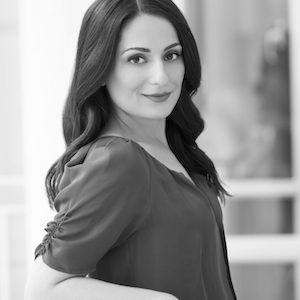3 Easy Investing Tips to Help Your Money Grow (Even If You Don’t Have Much to Start With)
If, for you, "investing" is one of those intimidating, nebulous-feeling grownup words—you know, like "mortgage" or "cholesterol"—you're far from alone. It's easy to know you're supposed to be doing it, but figuring out that first step can be paralyzing (and clouded in financial jargon). Chase Slate Financial Education Ambassador Farnoosh Torabi is here to break it all down for you so that you can finally start diversifying your portfolio (you'll know what that means by the end of this article—promise).

You work hard to provide for yourself—both now and down the road. Why not put your paycheck to work, too? If you're already investing through your company's 401(k) or another type of retirement plan, you're off to a good start. (And if you're not yet saving for retirement, what are you waiting for?) But by setting up supplemental investments, you can help ensure you're happy and healthy long after you quit that daily 9-to-5 grid.
There are a plethora of ways to invest (more on that in a sec), but whatever you choose, it’s important to run the numbers to be sure that the cash you’re on track to earn is an amount you think will be “enough,” based on the lifestyle you’d like to have in retirement. And keep in mind, we're living longer than we ever have before.
As you start to build a portfolio that will get you where you want to go, here are a few key things to keep in mind.

1. Mix it up
Your options for investing are almost endless—to the point where it can be hard to know where to start. So, let's get into it. There are a few different asset classes you’ll probably hear about most frequently, and they all involve different levels of risk. You’ve got:

{{post.sponsorText}}
Stocks, or shares, issued by a corporation: These are considered high-risk, but they’re also potentially high-reward.
Bonds: Essentially loans you issue to big companies or governments. These are pretty low-risk, but you’re not going to see as impressive a return as you would with stocks.
Mutual funds: These are usually a combination of stocks and bonds. They're often safe bets because you’re mitigating your risk by diversifying your holdings.
Index funds: Represent a predetermined segment of a market (like the S&P 500). Indexing is a relatively safe, low-cost way to invest; there isn’t a lot of active management that needs to happen, because they just ride the particular market they’re indexed to.
Exchange-traded funds: ETFs, as they're known, also comprise assets from a specific index but are about as easy to unload as stocks.
When putting together a portfolio, it’s important to strike the right balance between riskier assets (like stocks) and safer ones (like bonds). The younger you are, the more risk you can afford to take on. Just how risky can you be? Well, that's up to you. But a good rule of thumb is to take 100 and subtract your age—the number you’re left with is the percentage of your portfolio you can have safely invested in stocks.
As you get closer to retirement, you don't really want to take on as much risk. You have less time to make up for extreme volatility in the market, which means you should reduce your exposure to riskier asset classes and put more money in safer havens like bonds.

2. Seek out experts
Maybe you launched a business. Maybe you’re starting a family. Maybe you’re divorcing. If you’re going through a big life change, or just feel overwhelmed by your financial situation in general, you may want to find an objective partner who can help keep you on track and make sure you’re hitting your goals. That’s where a financial advisor comes in handy. Ideally, this is someone who looks at your financial life holistically; he or she isn’t just concerned with your investment portfolio.
When my husband and I got married, we worked with a financial advisor. We were combining our assets, we knew we wanted to have kids, and we wanted to go about everything the right way. On top of everything else we discussed, our adviser thought to do an audit to see if we were insured enough. She told us, “It’s time to get life insurance, guys.” She also explained how important it was for me as the breadwinner to have disability insurance, and then she referred us to a great insurance agent.
Financial advisors aren’t as expensive as you’d think: Though rates vary, they tend to charge around 1 percent of your underlying assets every year. Some advisors are also happy to meet with you a couple of times, or on an as-needed basis, and charge just for those sessions. If you’re interested in speaking to a financial advisor, check out the National Association of Personal Financial Advisors (NAPFA.org) or xyplanningnetwork.com. Interview at least three people and make sure you feel good about them. They shouldn’t make any crazy promises about the kinds of returns you’re going to see, and, if they’re doing their job right, they’ll ask lots of questions about all aspects of your financial life.

3. Ride it out
By now you’re (hopefully) in the habit of checking your savings and checking account balances every day. But if you’re new to investing, the last thing you want to do is check your portfolio too frequently. The market’s constant ups and downs will only drive you crazy! Remember: When you’re investing for the next 30 years, whatever happened over the past hour doesn’t really matter.
Instead, I suggest checking in once a quarter to make sure your investments are still in line with the goals you’re working towards. If you see that your asset mix isn't performing, switch it up. Some portfolios will do that for you by auto rebalancing, meaning they’ll adjust the allocation of your investments if changes in the market throw your desired stock/bond ratio out of whack.
Just like with your regular savings accounts, it pays to make sure you’re automatically contributing to your investment accounts every month. If you’re consistently devoting 10 to 15 percent of your income to retirement over the next 30 or 35 years, if you’ve diversified your investments and you’re adjusting the balance of assets based on your age, you should be in a really good place when you’re ready to start the next chapter of your life.
Farnoosh Torabi is one of America’s leading personal finance authorities. From her early days reporting for Money magazine to hosting a primetime series on CNBC to becoming a Chase Slate Financial Education Ambassador, she’s become a go-to money expert. Millions of Americans tune into Farnoosh’s award winning podcast, So Money, and her work and advice have been featured in The New York Times, The Wall Street Journal, O, The Oprah Magazine, Fortune, Forbes and Time. For more, check out www.Farnoosh.TV.
Speaking of the future of your finances: Here's how how to negotiate the salary you deserve, and how to spend less and save more.
SaveSaveSaveSaveSaveSave
Loading More Posts...